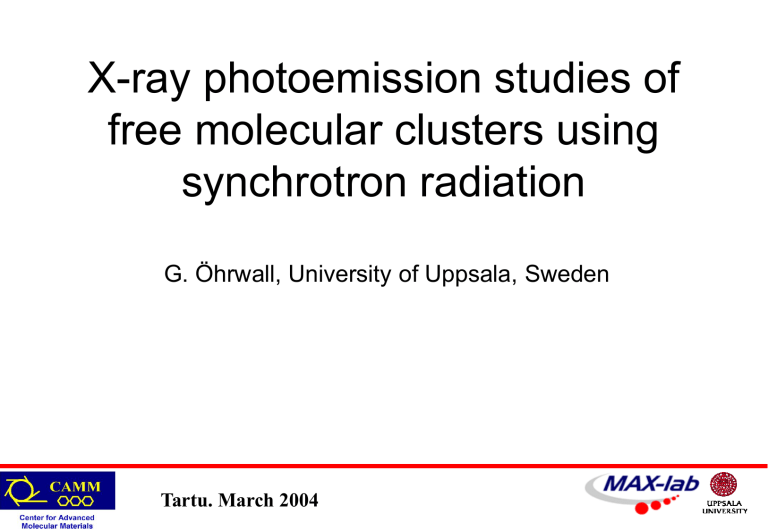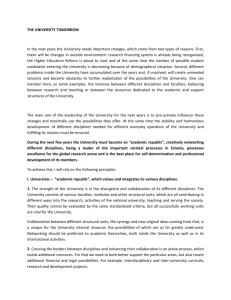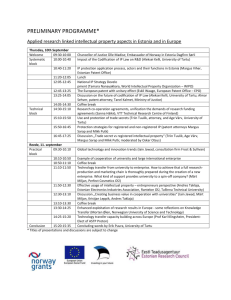
X-ray photoemission studies of free molecular clusters using synchrotron radiation G. Öhrwall, University of Uppsala, Sweden Tartu. March 2004 Why clusters? Bridge between the isolated atom and the infinite solid Size-dependent physical and chemical properties Microscopic origin of macroscopic properties Applications? Tartu. March 2004 Cluster production Skimmer P≈1-10 bar ions, e- P≈10-3 mbar SR Nozzle d≈100 mm Turbopump Tartu. March 2004 <N> = <N>(T, D, p, k) <N>≈2000 XPS of Ar clusters 2p3/2 XPS + -+ -+ -+ + + ++- + + PRL 74, 3017 (1995), JCP 104, 1846 (1996) Tartu. March 2004 + CO2 cluster XPS Same shift for C 1s and O1s van der Waals bonded - mainly final state relaxation Core hole screening Tartu. March 2004 C2H5OH cluster XPS Tartu. March 2004 Core level shifts for ethanol clusters Chemical shifts DE(O 1s)=1.3 eV DE(C 1s, intermediate)=0.95 eV DE(C 1s, methyl)=0.9 eV Tartu. March 2004 Core level shifts for ethanol clusters Chemical shifts DE(O 1s)=1.3 eV DE(C 1s, intermediate)=0.95 eV DE(C 1s, methyl)=0.9 eV Weak initial state effects - hydrogen bonding Tartu. March 2004 Core level shifts for ethanol clusters Chemical shifts DE(O 1s)=1.3 eV DE(C 1s, intermediate)=0.95 eV DE(C 1s, methyl)=0.9 eV Weak initial state effects - hydrogen bonding Chemical shift predominantly relaxation effect Tartu. March 2004 Core level shifts for ethanol clusters Chemical shifts DE(O 1s)=1.3 eV DE(C 1s, intermediate)=0.95 eV DE(C 1s, methyl)=0.9 eV Weak initial state effects - hydrogen bonding Chemical shift predominantly relaxation effect Different screening implies different coordination for O and C atoms - depends on geometry Tartu. March 2004 CH3OH cluster XPS Size dependent vertical shift Difference C1s-O1s similar to ethanol: 0.3-0.4 eV Tartu. March 2004 Locailzed or delocalized final states? Molecule Cluster + + ++ ++ + + Tartu. March 2004 XPS and Auger shifts Molecule Cluster DE=X +1 core ionized state DEAuger=4X-X=3X DE=22X=4X +2 valence ionized state Tartu. March 2004 Ar cluster Auger Intensity (arb. Units) Ar LMM <N>≈200 hn=310 eV Cluster spectrum (surface and bulk) modelled as shifted and broadened version of atomic Auger spectrum. DE=3X works for surface and bulk! 200 202 204 206 208 210 Kinetic Energy (eV) Tartu. March 2004 212 214 Liegner and Chen JCP 88, 2618 (1988) H2O Auger Molecule theory Ice theory Ice exp Localized picture insufficient. ? DE≈3eV Cluster exp Molecule exp DE≈8eV 470 480 Tartu. March 2004 490 500 KE (eV) 510 Misinterpreted solid AES? Ultra fast dissociation in resonant Auger decay SR |i> (intermediate state) Dissociation can occur on same time scale as core hole life time - few fs for k-shell in second row elements. |f> (final state) |i> (ground state) Tartu. March 2004 Ultra fast dissociation gives rise to features constant in kinetic energy Ultra fast dissociation in CH3Br clusters Br 3d5/2 -> 4a1 4a1 resonance known to give rise to ultra fast dissociation (Nenner & al., J. Electron Spectrosc. Relat. Phenom. 52, 623 (1990)) Tartu. March 2004 CH3Br cluster RAS UFD features as intense in molecules and clusters - not surface effect! Tartu. March 2004 Summary Third generation synchrotron radiation offers new possibilities to study free clusters Core level PES on clusters gives information on local surrounding - surface/bulk, geometry Localization/delocalization of two-hole final states in AES Possible to observe femtosecond nuclear dynamics in core excited state in “solid” Tartu. March 2004 Acknowledgements Maxim Tchaplyguine MAX-lab Joachim Schulz Olle Björneholm Uppsala University Marcus Lundwall Andreas Lindblad Torbjörn Rander Svante Svensson Tartu. March 2004 Acknowledgements Dept. of Physics, Uppsala Olle Björneholm Marcus Lundwall Svante Svensson Andreas Lindblad Raimund Feifel Torbjörn Rander MAX-lab, Lund Maxim Tchaplyguine Stacey Sorensen Financial Support KAW, SSF Tartu. March 2004 Andreas Lindgren Cluster beam size Scienta SES-200 detector image Slit 25 mm Magn.=5x Pos. Atomic Ar width ≈5 mm Cluster Ar width >1 mm 5 cm from nozzle Atomic Ar 3p-lines Tartu. March 2004 Cluster Ar 3p-lines Kinetic Energy CO2 cluster valence PES Shifts depend weakly on electronic state Vertical shifts similar to core level shifts (screened 1-hole states) Tartu. March 2004 H2O cluster valence PES hn=60 eV X A-state ((3a1)-1) more affected by cluster formation than X or B. Cluster+Mol. B A Mol. 20 18 16 14 Binding Energy (eV) Tartu. March 2004 12 10 Clustering from a binary gas mixture Pure expansion: <N> = <N>(T, D, p, k) Mixed A B expansion: <”N”>= <”N”>(T, D, p, kA, kB, rA/B) Present experiment: • T, D, p fixed • kA, kB, rA/B varied Tartu. March 2004 Valence PES (UPS) Core-level PES (XPS) NEXAFS PE(PI)nCO TOF-MS Homogenous mixing Radial segregation Tartu. March 2004 Radial layering Non-mixing Ar/Kr clusters from 1.8% Kr in Ar XPS @ 50 eV Ek + + - + - + -+ + + + Ar 2p3/2 Bulk: less Ar, more Kr Surface: more Ar, less Kr Kr 3d5/2 0.0 -1.0 Relative binding energy (eV) Tartu. March 2004 Structure of Ar/Kr mixed clusters Bulk: less Ar, more Kr Surface: more Ar, less Kr Ar/Kr radial gradient Tartu. March 2004 Ar/Xe clusters XPS @ 50 eV Ek Xe 4d5/2 0% 2.1% 2.7% 3.2% 5.3% 100% Ar 2p3/2 Tartu. March 2004 O2 cluster XPS Exchange splitting same in molecule and cluster Tartu. March 2004 O2 cluster NEXAFS Valence orbitals less affected by cluster formation than Rydberg states. Recorded RAS on top of s* Tartu. March 2004 O2 cluster RAS Cluster spectrum contains features consistent with ultra fast dissociation Tartu. March 2004




